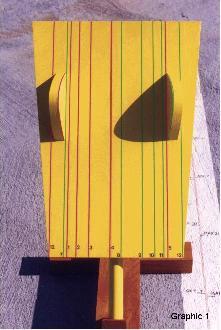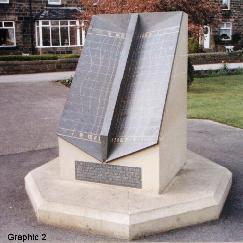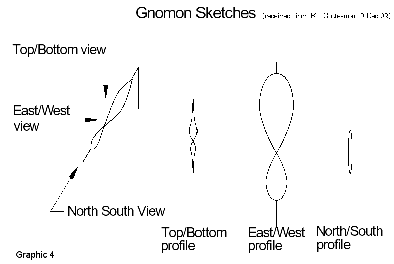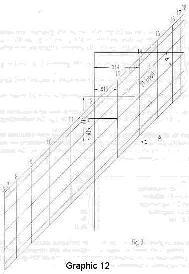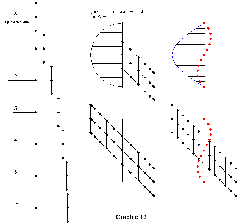A Quest for a Civil Time Polar Sundial
(Assembled 5 Jan 2003 by Mac Oglesby)
Introduction
Courtesy of
Dave Bell, this site is a temporary home for certain materials which relate to
the quest for a civil time polar sundial, as discussed during recent weeks on
the Sundial Mailing List and in private email messages. These materials are
gathered here to make it easier for interested sundial list members to access
the photos and drawings whose size exceeds that allowed for attachments. I
apologize in advance if I have misrepresented or misunderstood anyone, and I take
full responsibility any typos and other errors which occur as a result of my
editing.
The Problem
Dialist John
Close asked for help in designing a civil time polar sundial that didnít use
analemmas, half analemmas, or unfolded analemmas. He wondered if a gnomon could
be constructed which would satisfy his requirements.
The dialists he
contacted gave differing advice as to the possibility of such a gnomon: some
said yes, some said no, and some said maybe. †Thatís about where we are still, but the journey has been
interesting.
The Journey
To clarify our
thinking, letís consider what a polar sundial is, and perhaps mention what the
sundial user must do in order to obtain civil time.
A very strict
definition of a polar might be that it has a flat dial face which lies parallel
to the Earthís axis and perpendicular to the plane of the meridian, has
straight hour lines, and has either a pointed post gnomon, or a straight edge
gnomon parallel to the Earthís axis. (The edge gnomon may be replaced by a taut
cable.)
[NOTE:† Commenting on my draft, Fer de Vries writes,
ďI call any dial parallel to the earthís axis a polar dial. Also the east and
west facing dial, and many more, are polar. But this is arbitrary of course.Ē I
agree with Fer, knowing that others will disagree.]
This strict
polar dial would commonly be delineated to show solar time, but never as many
as 12 hours in a day. Though it may easily be designed to show zonal solar
time, to get civil time one must consult a graph or table of EoT values, which
are then applied to the dialís reading.
As we alter the
strict definition, our polar dial becomes a modified polar. One useful
modification would be to allow the dial plate to be rotated around an axis
parallel to the Earthís, such as the edge of the gnomon, or an edge of the dial
face. [Fer writes, ďIn my definitions it stays a polar dial if you rotate the
plate. The equivalent horizontal dial is always at latitude 0 degrees. The pole
style always is parallel to the dial.Ē] If the dial is turned 15 degrees, the
time on the dial will be 1 hour earlier or later, depending upon which way it
is rotated. To change the dial time by 4 minutes, turn it 1 degree, etc. Thus
we can easily make allowance for summer time, and/or longitudinal offset,
and/or EoT, although, since the EoT value is constantly changing, one would
need to reset the dial now and then.
H. Robert
Mills, in his book ďPractical Astronomy,Ē details such an arrangement on pages
106-109, where he suggests using a wedge to rotate the dial plate. Also, his
polar dial has each end of the dial plate folded up 90 degrees, which shortens
the length of the dial and makes it usable for a full 12 hours.
The Journey Continues
The final group
of exhibits in this collection from The Dutch Sundial Society consists of 5
pages and a diagram. These items are labeled as Graphic 6 through Graphic 11,
just for identification purposes. I donít read Dutch, so I asked Fer de Vries
for comments. Gracious as always, Fer provided the following text, in two
parts.
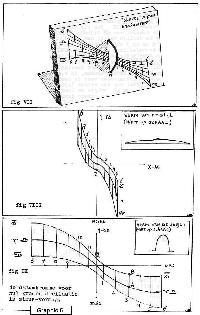 |
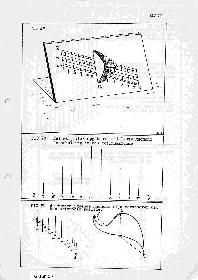 |
 |
| Graphic 6 | Graphic 7 | Graphic 8 |
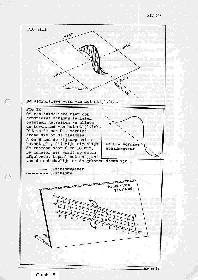 |
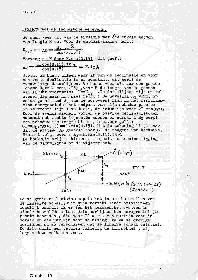 |
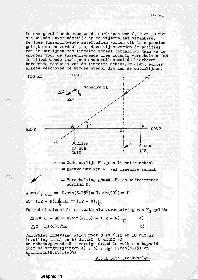 |
| Graphic 9 | Graphic 10 | Graphic 11 |
Part 1 of Text
by Fer J. de Vries
The dial you
mentioned [see Graphic 5] was an idea of Willem Bits.
He started
after he had seen the polar dial of Thijs de Vries, the dial recently spoken
about on the list.
A polar dial is
the same as an horizontal dial at latitude 0 and then itís rather easy to
visualize the process.
The first goal
of Bits was to make equidistant hour lines.
Place a
vertical gnomon with length g1 on the north-south line.† At one oíclock this points to the hour line
1 at distance x1 from the n-s line.
Place a second
gnomon on the north-south line with length g2 but shorter than g1.
This second
gnomon has to point to hour line 2 at a distance x2 from the n-s line that is
twice the distance of the hour line 1.
Do this for all
the hours and the hour lines are equidistant and we have a number of gnomons on
the n-s- line.†† (Shall we call them
hour gnomons?) The distance between all these gnomons is arbitrary.
You may choose
any space between the gnomons but keep them on the n-s- line.
If you do this
process for all the times and not only for the hours you get a plate with a
curved edge on the n-s- line.
But you canít
read the time. What gnomon has to be used?
So incorporate
the date and also draw date lines.
For each hour
line and its related gnomon the points for the dates on that hour line may be
calculated.
Connect all the
points for a certain date with a curve and you have the date lines also.
Now the dial
may be read at the intersection of the date line and the shadow of the edge of
the plate on the n-s- line.
See [Graphic 6]
for some possible solutions.
Many shapes are
possible, depending where you place the gnomons.
Have in mind
that the pattern isnít in the east-west direction but in an arbitrary
direction.
The hour lines
are equidistant.
If you place
the hour-gnomons also equidistant then the date line for 0 degrees is a
straight line, else this date line is curved.†
If the distance between the gnomons is the same as the distance between
the hour lines the angle of the equinox line is 45 degrees.
This was
published in our bulletin in March 1981.
Part 2 of Text by Fer J. de Vries
In the previous
part you saw a polar dial with equidistant hour lines and the equinox line as a
straight line, but all other date lines as curves.† The gnomons for each hour are on a n-s line and all equidistant
apart.
Otherwise the
equinox isnít straight.
Assume:
n = the hour (6
-18)
q = equidistant
distance between hour lines
gn = height of
gnomon (g0, g1 .... g6)
We now have:
gn = (12- n) * q
/ tan (n*15)
For hour 6 and 18
this gives g6 = g18 = 0
For hour = 12
(noon) the equation fails.
Take n = 0.0001.
Then g0 is about 3.82 q
The distance
between a point on the straight equinox line and a point on another date line
is
delta = tan
(decl) * (n-12) * q / sin (n*15)
Because of the
equidistant hour lines any correction for longitude and EoT can be made by
shifting the hour lines or the combination of gnomons and date lines.
But it canít
have a built in EoT correction.
----------------------------------
Second problem to
solve.
Now we try to
make all the date lines straight.
For a normal
polar dial the distance of a date point from the equinox line is:
y = g tan (decl)
/ cos (n*15)
We want to have
y as a constant value to get parallel lines to the equinox line and name that
value k.
We then have:
g tan (decl) /
cos (n*15) = k
and g = k * cos
(n*15) / tan (decl)
We choose for k :
k = k1 * tan
(decl)
which is
allowed because for a certain date decl is constant and also tan (decl) is
constant.
and then gn = k1
* cos (n*15) in which k1 = k / tan (decl) is a constant.
Again place a
number of such gnomons on the n-s- line.
The other hour
lines are shifted and we want to shift them back as may be seen in fig. VII on
page 702† [see Graphic 8].† This shift is in x and y direction.
Well, do this
including the appropriate gnomon for that hour and all the hour lines become
equidistant again.
And the final
gnomon wire gets its nice curve.
But still the
EoT isnít built in and I donít see a possibility for that.
At page 704
[Graphic 10] and 705 [Graphic 11] Bits gave the formulas.
The gnomon g12 is
H
For any other
gnomon gn = H cos (N*15)
Distance of the
date line
AB = .... = H tan
(decl)
That is a
parallel line to the equinox line.
The shadow length
of a gnomon for decl = 0 is:
SL = .... = H sin
(N*15)
and the distance
AN = H sin (N*15)*tan(alpha)
This alpha may be
chosen at will.
At page 705
[Graphic 11] the shift is described.
The not linear
hour line _._._. has to be shifted to ........
The final
formulas you need for the wire are:
(a) for
the x shift
(b) for
the y shift
Hn for
the height of the hour gnomon
An for
the place of that hour gnomon
With g12
the hour lines can be calculated.
And alpha
is your own choice.
[end of
text by Fer de Vries]
Conclusion
Although we
havenít (yet) found a gnomon shape which gives civil time directly on a polar
dial, speaking personally, Iíve learned several new things about polar
sundials. And there always seem to be new lessons around every bend in the
road.
If any reader
has new thoughts on this problem of civil time on a polar dial, please post to
the sundial mailing list, or write to me at††
<[email protected]>.
After the Conclusion - the Quest Continues!
On 10 January 03, Fer J. de Vries sent some additional information to
the Sundial Mailing List. He wrote:
As a contribution to the discussion about the polar dial I made a drawing of
the construction of such a dial.
In this picture [see Graphic 13] I try to explain what I did.
At the left from top to bottom you find a series of gnomons for each hour
starting at noon with the appropriate hour line with date points for the
solstices and equinoxes.
The foot points of the hour gnomons are drawn in red.
The foot points for 6 and 18 are arbitrary because the gnomon length is 0.
Now it's easy to draw a side view of the wire. We know the distance of
the foot points from the center point and the lengths of the hour gnomons.
The figure at top right shows roughly the result in blue.
Reading the time before about 7 am and after 5 pm is difficult because
the length of the hour gnomon is small.
If I didn't make a mistake I conclude that the principle by Bits is all
right but his drawings are somewhat misleading.
[end of
text by Fer de Vries]
